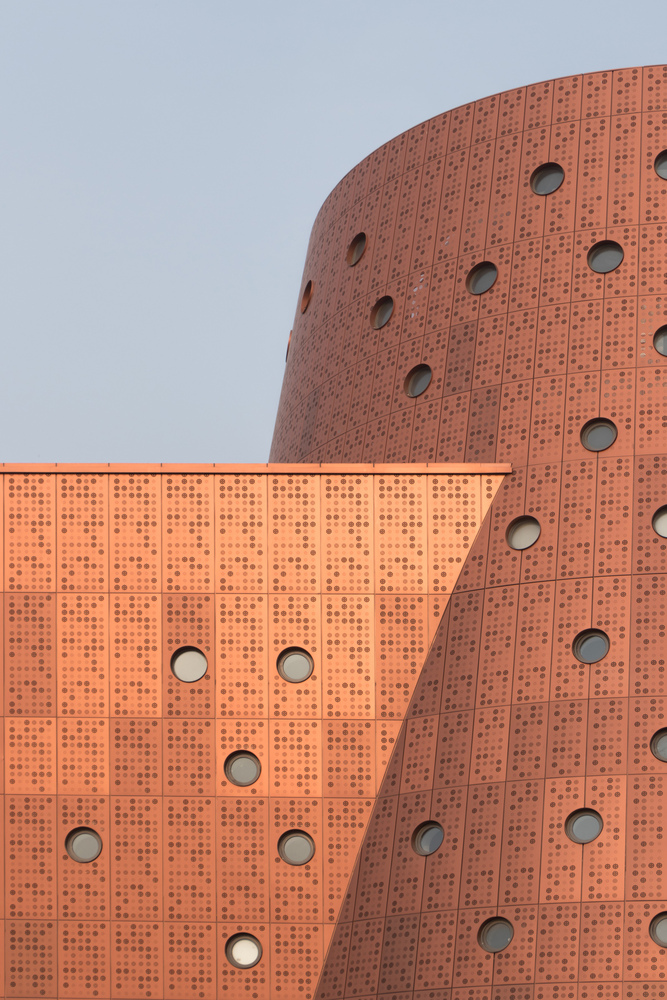Paz - Comedias House Ramon Esteve
2015-02-27 04:00
© Christoph Kicherer para Bul- thaup
c Christoph Kicherer parBul-thaup
.jpg)

架构师提供的文本描述。山景,加上巨大的石挡土墙,是这座房子布局设计的源头。位于巴伦西亚萨格托的一个住房州,位于卡尔德罗纳山脉的底部。
Text description provided by the architects. A mountain landscape, with big stone retaining walls, is the origin of the design of the layout of this house. Located in a housing state in Sagunto, Valencia, at the base of the Calderona Range, the Paz & Comedias House is fully integrated with its envi- ronment by reusing the red sandstone, extracted while opening the foundations, in the masonry walls.
Courtesy of Ramón Esteve
Ramón Esteve提供
.jpg)

因此,排列空间的墙是平行的,垂直于山坡。这和石头一起,把房子和风景融为一体。
Thus, the walls that arrange the spaces are parallels to each other and perpendicu- lar to the mountain slope. Together with the stone, this merges the house with the landscape.
© Christoph Kicherer para Bul- thaup
c Christoph Kicherer parBul-thaup
.jpg)

宽阔的玻璃窗覆盖着石墙,使山间和山谷之间完全透明,并强调了墙的巨大性。
Wide glass panes encloses the stone walls, allowing total transparency between the mountain and the valley and emphasising the massiveness of the walls.


向东看,朝海的视野变得更宽了。在这个立面上,主要的元素是主卧室的阳台。一个非常高的阳台,提供了一种失重的感觉和广阔的景观。
Eastwards, the views become wider towards the sea. On this façade, the main element is the balcony of the main bedroom. A balcony that hangs really high, offering a great feeling of weightlessness and broad views of the landscape.
© Jonathan Segade
c.Jonathan Segade
.jpg)

相反,房子的西侧被一个亲密的空间所限制,这是通过把房子和山分开而得到的。石墙在这里起支撑作用,形成一个庭院,在房子和景观之间起到过滤的作用。这个外部空间连接了以前的住宅和它的延伸,成为房主艺术画廊的大厅。由于这一点,房子的大部分私人部分和它的流通被安排在这个区域。
On the contrary, the western side of the house is limited by an intimate space, obtained by separating the house from the mountain. The stone walls work here as buttresses and create a courtyard that acts as a filter between the house and the landscape. This exterior space links the previous dwelling to its extension and becomes the lobby for the homeowner’s art gallery. Due to this, the most private parts of the house and its circulation are laid out in this zone.
Courtesy of Ramón Esteve
Ramón Esteve提供
.jpg)

在房子里,主要的特征是空间之间的流体连接。使用很少的材料和元素,如墙壁和玻璃开口的布置,有助于房间之间的清晰连续性。灰色的乌勒德科纳石用于铺路和浴室柜台;外部木匠的颜色由层叠的伊罗科木调和红砂岩墙组成;室内墙壁和白色家具构成一种安静而流畅的气氛。
Inside the house, the main feature is the fluid connection between spaces. The use of few materials and elements, such as the arrangement of the walls and the glass openings, contributes to a clear continuity between rooms. Grey Ulldecona stone is used for the pavement and also for the bathroom counters; the colour of the external carpentry made of laminated iroko wood tunes with the red sandstone walls; interior walls and furniture in white complete a quiet and fluid atmosphere.
Floor Plan


Courtesy of Ramón Esteve
Ramón Esteve提供
.jpg)

Floor Plan


最后,一所房子的颜色和材料的精确使用和精确的几何组合,形成一个伟大的了望塔,微妙和严格地结合在一起的景观。
Finally, a house where an exact use of colours and materials and a precise geometry are combined to form a great watchtower, subtly and austerely integrated into the landscape.
Courtesy of Ramón Esteve
Ramón Esteve提供
.jpg)

.jpg)

.jpg)

.jpg)

.jpg)

.jpg)

.jpg)

.jpg)

.jpg)

.jpg)

.jpg)

.jpg)

.jpg)

.jpg)

.jpg)

.jpg)

.jpg)

.jpg)

.jpg)











Architects Ramon Esteve
Location Sagunt, Spain
Category Houses
Area 886.0 sqm
Project Year 2010
Photographs Jonathan Segade, Christoph Kicherer para Bul- thaup
























